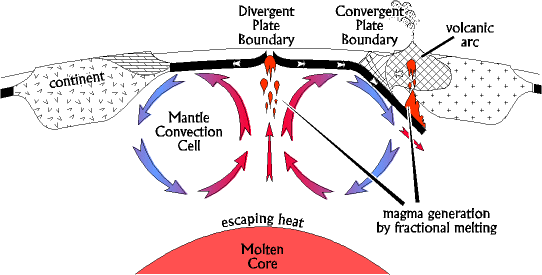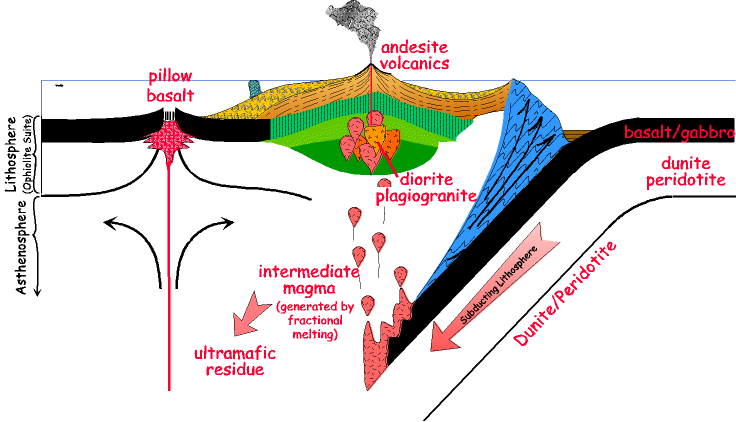PLATE TECTONICS, VOLCANOS AND IGNEOUS ROCK EVOLUTION
One of the most important ideas in geology is that igneous rocks evolve, and they evolve at convergent and divergent plate boundaries.
With the exception of hot spots (see below) all volcanic activity takes place at convergent and divergent plate boundaries. At divergent plate boundaries ultramafic magma is brought from deep in the mantle toward the surface via convection cells. This material is very hot, but under enormous pressure, so that we would think it was a solid. But it does flow, very slowly, centimeters a year.
As it approaches the surface, however, the reduction in pressure allows the rock to partially melt (or fractionally melt). The melt portion (mafic) is lower in temperature than the unmelted portion (ultramafic), and it rises to fill the space opening between the diverging plates.
Here is the creation of new oceanic lithosphere (see ophiolite suite). But it is also the creation of new rock. The original rock (parent rock) has been split into two fractions, an ultramafic unmelted residue, and a melted mafic portion.
Creation of new oceanic lithosphere involves massive amounts of volcanic activity, typically in the form of fissure volcanos, but most of it we cannot sea because it is below sea level.
A second fractional melting takes place at convergent plate boundaries (subduction zones). As oceanic lithosphere descends into the mantle it carries a lot of sea water with it. The sea water acts as a flux causing the material above the subducting plate to fractionally melt. This produces first intermediate magmas, and then felsic magmas, and since these rocks are lighter than mafic magma they float higher in the earth, forming islands and eventually continents (click image for enlargement; or see this link).
 Intermediate and felsic magmas also produce some of the most spectacular and explosive volcanos in the world - composite type. Common examples include Mt. Saint Helens, Mt. Rainier, Mt, Vesuvius, Mt. Pinatubo, Santorini, and Mt. Fuji (click for pictures, or descriptions). In fact, all the volcanos that form the Andes mountains, and the Cascade mountains in the northwest U.S. are this type. All thanks to plate tectonics and subduction.
Intermediate and felsic magmas also produce some of the most spectacular and explosive volcanos in the world - composite type. Common examples include Mt. Saint Helens, Mt. Rainier, Mt, Vesuvius, Mt. Pinatubo, Santorini, and Mt. Fuji (click for pictures, or descriptions). In fact, all the volcanos that form the Andes mountains, and the Cascade mountains in the northwest U.S. are this type. All thanks to plate tectonics and subduction.A summary of these igneous evolutionary processes is shown in the diagram below.

A third major category of volcanic activity has little to do with plate tectonics. Indeed, like the majority of volcanos hot spot volcanos often (but not always) occur within plates. They are generated by isolated, stationary, plumes of magma that arise deep in the mantle. Common examples are the shield volcanos of the Hawaiian islands, and Yellowstone park.
Go On To: